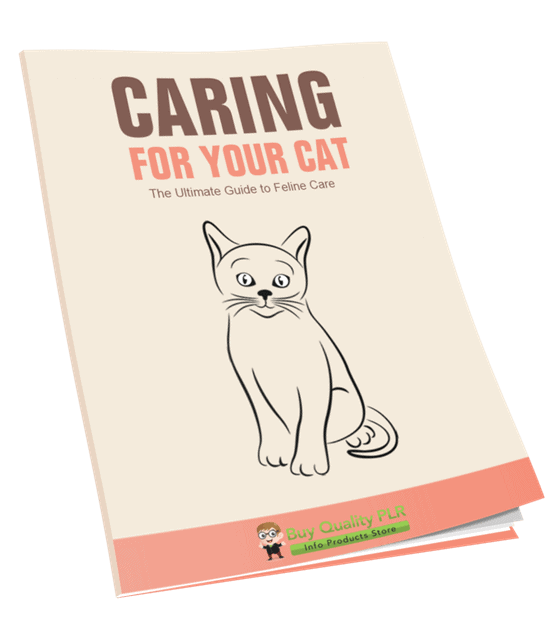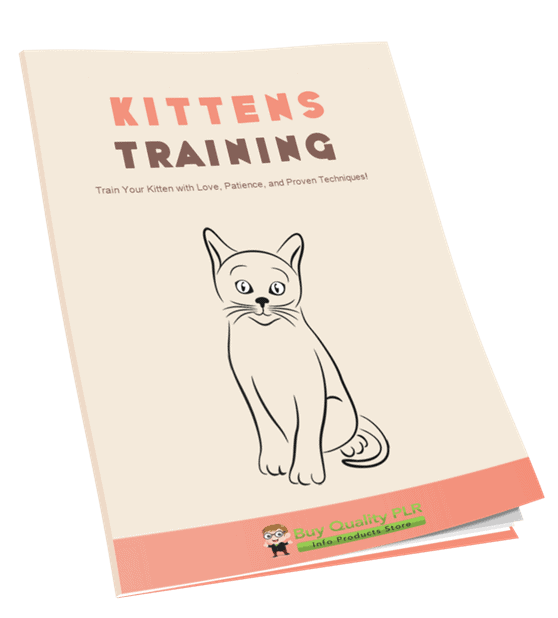
Caring For Your Cat PLR Course 31k Words
in Cats PLR Ebooks , Pets PLR , Pets PLR Ebooks , PLR Checklists , PLR eBooks , PLR eCourses , PLR List Building Reports , Premium PLR , Premium PLR eBooks , Premium PLR Reports , Premium White Label Brandable PLR Coaching Courses , Private Label Rights ProductsChoose Your Desired Option(s)
has been added to your cart!
have been added to your cart!
#catcare #catlovers #petcareplr #cattraining #felinehealth #cattips #catcontent #plrcourse #caringforcats
Caring For Your Cat PLR Course: The Ultimate Guide to Feline Care
Welcome to the “Caring For Your Cat” PLR Course! If you’re passionate about cats and want to provide top-notch care for your feline companions, this is the course for you. Whether you’re a new cat owner or a seasoned pro, this course will guide you through the essential steps needed to ensure your cat lives a happy, healthy, and enriched life.
Course Overview:
Course Title: Caring For Your Cat
Total Word Count: 29,578 words
Format: PLR Course
Content Included: 5 Detailed Modules, Checklist, FAQs, and Salespage
This course provides practical, easy-to-follow steps for cat owners to improve their pet’s health, happiness, and behavior. It covers everything from creating a comfortable home for your cat to understanding their behavior, grooming needs, and building a strong bond. You will learn how to provide the best possible care for your cat while respecting their natural instincts and preferences.
Presenting…
Caring For Your Cat PLR Course 31k Words
What’s Included in the Course Package?
The Caring For Your Cat PLR Course is divided into five modules, packed with valuable insights and actionable tips. Here’s a breakdown of the modules and what’s included:
Module 1: Setting Up a Comfortable Home for Your Cat
A cat’s home should be a sanctuary, and this module will guide you through the process of creating the ideal living environment.
- Choosing the Right Space for Your Cat: Select a peaceful area in your home where your cat can retreat and relax.
- Preparing a Comfortable Sleeping Area: Set up a cozy bed or cushion to ensure your cat gets the rest they need.
- Providing Litter Box Essentials: Learn the best practices for setting up and maintaining a clean and accessible litter box.
- Cat-Proofing Your Home: Eliminate potential hazards and create a safe environment for your cat.
Module 2: Nutrition and Feeding Your Cat
A well-balanced diet is crucial for your cat’s health. This module will help you understand how to provide the right nutrition for your feline friend.
- Understanding Your Cat’s Dietary Needs: Learn how to choose the right food based on your cat’s age, breed, and health.
- Setting a Feeding Schedule: Establish regular meal times to ensure your cat gets the proper nutrients.
- Providing Fresh Water Daily: Understand the importance of hydration and how to encourage your cat to drink more water.
- Avoiding Harmful Human Foods: Learn about foods that are toxic to cats and how to avoid feeding them dangerous items.
Module 3: Grooming Your Cat
Regular grooming helps keep your cat clean, healthy, and comfortable. This module provides essential tips on grooming your cat.
- Brushing Your Cat’s Fur Regularly: Prevent matting and reduce shedding with regular brushing.
- Nail Trimming and Care: Learn the proper techniques for trimming your cat’s nails to prevent overgrowth and discomfort.
- Bathing Your Cat: Understand when and how to bathe your cat, ensuring a stress-free experience for both of you.
- Dental Hygiene for Your Cat: Learn about the importance of dental care and how to keep your cat’s teeth and gums healthy.
Module 4: Understanding Your Cat’s Health and Behavior
This module focuses on your cat’s physical and emotional health.
- Regular Vet Check-ups: Learn why regular vet visits are essential for your cat’s health and well-being.
- Recognizing Signs of Illness: Understand how to spot the early signs of illness in your cat.
- Understanding Cat Body Language: Learn how to interpret your cat’s behavior and body language to better understand their needs.
- Managing Stress and Anxiety in Cats: Discover how to create a calming environment and help reduce stress for your cat.
Module 5: Building a Strong Bond with Your Cat
A strong bond with your cat is essential for their emotional well-being. This module will help you deepen your connection with your feline friend.
- Spend Quality Time Together: Discover the importance of play and interaction in building a strong bond with your cat.
- Training Your Cat with Positive Reinforcement: Learn how to use treats and praise to train your cat and promote good behavior.
- Creating a Routine for Stability: Help your cat feel secure by maintaining a consistent daily routine.
- Respecting Your Cat’s Boundaries: Understand the importance of giving your cat space and respecting their natural behaviors.
Additional Materials Included:
- Caring For Your Cat – Checklist (539 words)
A concise checklist to help you ensure that you’re covering all essential aspects of cat care. This is perfect for quick reference or for printing as a guide. - Caring For Your Cat – FAQs (1,087 words)
A comprehensive FAQ section answering common questions about cat care, from diet and grooming to behavior and health concerns. - Caring For Your Cat – Salespage (658 words)
A professionally written sales page that you can customize and use to sell the course. It’s designed to effectively convert visitors into customers.
How to Use and Profit from the Course
The Caring For Your Cat PLR Course offers numerous opportunities to monetize and expand your business. Here’s how you can profit from this valuable content:
- Sell the Course as a Digital Product:
Package the course and sell it as a standalone product through your website or online marketplaces. Customize it with your branding and start selling it right away. - Create an Online Course or Membership Site:
Use the course as the backbone of an online learning platform or membership site. Offer ongoing access to cat care content, consultations, and more. - Offer One-on-One or Group Coaching:
Use the course material to create a coaching program for new cat owners, offering personalized advice on caring for their cats. - Repurpose into Smaller Products:
Break the course into smaller, bite-sized products (e.g., eBooks, reports, articles) that you can sell individually or bundle together. - Affiliate Marketing Opportunities:
Include affiliate links to cat care products, grooming supplies, and pet food within the course content to earn commissions when your customers make purchases. - Create a Physical Product:
Convert the content into a physical guide or workbook that can be sold in pet stores or online platforms. - Run Workshops or Webinars:
Use the course as content for workshops or webinars, allowing you to teach cat owners in a more interactive format. - Use as Lead Magnet or Free Giveaway:
Excerpt portions of the course and use them as free resources to attract subscribers or as part of a promotional campaign.
Licensing and Usage Terms
The Caring For Your Cat PLR Course includes a commercial license, which allows you to:
- Sell the content as-is or make minor tweaks to make it unique.
- Break the course into smaller reports and sell them individually.
- Bundle the content with other products to create larger offerings.
- Use the content to create a membership site, or sell it as part of a subscription model.
- Convert it into videos, audios, or physical products for further monetization.
However, the following restrictions apply:
- You cannot pass the PLR rights to your customers.
- You cannot offer 100% commissions to affiliates promoting this product.
- The content cannot be given away for free in its entirety – it must be sold or repurposed.
- You cannot add this content to packages that have already been purchased by customers without additional purchases.
Start Helping Cat Owners Today!
The Caring For Your Cat PLR Course is a valuable resource that can help cat owners provide the best care for their pets. Whether you want to create a digital product, offer coaching, or build a membership site, this course gives you everything you need to get started. Don’t miss out on this opportunity to educate, engage, and profit from your love of cats! Start selling today!
has been added to your cart!
have been added to your cart!
Here A Sample of Caring For Your CatPLR Course
Course Overview: This course is designed for cat owners and enthusiasts who want to learn how to provide the best care for their feline friends. Whether you’re a new cat parent or a seasoned pro, this course will guide you through the essential steps to ensure your cat lives a happy, healthy, and fulfilled life.
Module 1: Setting Up a Comfortable Home for Your Cat
Step 1: Choosing the Right Space for Your Cat
Selecting the right space in your home for your cat is one of the most crucial aspects of creating a comfortable and safe environment for them. Cats are naturally independent animals, and they require areas where they can feel secure and relaxed. This is especially important in a home with multiple people or pets, as cats may need a quiet retreat to recharge. Let’s go over the detailed steps for choosing the perfect space.
1.1 Understand Your Cat’s Natural Behavior and Needs
Before you start selecting a location, it’s important to understand a cat’s basic instincts. Cats are territorial creatures, which means they often prefer to have their own space that they can control. Unlike dogs, they do not necessarily need to be surrounded by activity or noise. Instead, they seek environments that are quiet, comfortable, and provide opportunities for privacy.
1.2 Look for a Quiet, Low-Traffic Area
The first consideration is finding a quiet corner away from the hustle and bustle of the household. If your home has a lot of activity—children playing, conversations, or other pets—it is essential to provide your cat with a space that is away from these distractions. Cats may become stressed or anxious if they cannot find a place where they can retreat for peace and solitude.
In homes with multiple people or animals, it is also essential to find a location where the cat will not be disturbed. For example, you might want to avoid areas such as high-traffic hallways or rooms where guests frequently visit. If possible, choose a space that is quieter and more secluded, such as a bedroom, study, or a corner of the living room where your cat can curl up without interruptions.
1.3 Ensure the Space is Safe and Secure
Safety is a critical factor when choosing a location for your cat. This means ensuring that the space is free from hazards like toxic plants, electrical cords, cleaning chemicals, or other dangerous objects. For instance, electrical outlets or dangling wires can pose a risk if your cat is curious and decides to investigate.
If the chosen space is near a window, make sure that it is secure, as cats sometimes try to jump or explore from high places. You should also keep windows closed or screened, especially if your cat is prone to exploring outside or if you live in a multi-story building. Make sure there are no open doors or gaps in which your cat could escape.
1.4 Provide Comfort with Soft Bedding and Hiding Spots
Once you’ve chosen a quiet, safe corner, it’s time to make the space inviting for your cat. Cats love comfort, and providing soft bedding or cushions will make the space more attractive for them. Choose a comfortable cat bed, blanket, or soft pillow that your cat can nestle into. Cats prefer areas that are soft and cozy, as this allows them to rest comfortably and feel secure.
Additionally, cats often enjoy hiding or curling up in small, enclosed spaces. If possible, provide a hideaway bed or a cardboard box where your cat can go to feel safe. This type of enclosed space simulates a den, which is instinctual for cats, and gives them a sense of security.
1.5 Consider the Temperature and Ventilation
Cats are sensitive to temperature, so it’s important to choose a spot with a moderate climate. Avoid placing their resting area in direct sunlight for prolonged periods, as this may overheat them, or in cold areas, such as near drafty windows or air conditioning vents. The ideal space will have good ventilation while maintaining a comfortable temperature.
Ensure the space remains well-ventilated. A space that is stuffy or too humid may cause discomfort or health issues for your cat. If the area tends to get too warm during summer or too cold in winter, consider placing a fan or a heater nearby to adjust the climate to their needs.
1.6 Accessibility and Independence
Cats often prefer to choose when they want attention. Therefore, it is important to ensure that the space you designate for your cat is easily accessible but does not have to be directly in the center of attention. Cats love to have control over their surroundings, and a quiet area where they can go whenever they feel like it is ideal.
Avoid choosing spaces that require your cat to navigate busy areas or face obstacles. For instance, it might not be ideal to place their bed under heavy furniture where they might feel trapped. If you’re setting up a space in a room shared with other pets or family members, make sure your cat can easily retreat to it without feeling cornered.
1.7 Creating an Enrichment Zone
In addition to providing a safe and peaceful area for rest, you can also turn the chosen space into a mini enrichment zone. Place a scratching post, a couple of toys, or a cat tree nearby. Cats love climbing and scratching as these activities help them mark their territory and keep them mentally and physically engaged.
Having access to a variety of toys in their retreat area also allows your cat to entertain themselves when they feel like it, giving them a sense of independence and preventing boredom. Rotate the toys periodically to keep the area interesting and engaging.
1.8 Tailoring the Space to Your Cat’s Personality
Every cat is unique, and their preferences for space can vary. Some cats enjoy being in high-up places, while others prefer hiding in corners. Observe your cat’s behavior closely to determine the type of space they favor. For example, if your cat enjoys watching activity in the home, a perch or shelf near a window might be ideal. On the other hand, if your cat prefers solitude, a quiet nook or covered bed may be best.
Additionally, if your cat has specific health needs or is elderly, consider adding extra comforts, such as heated beds or orthopedic cushions to support their joints.
Conclusion:
Choosing the right space for your cat is an important first step in ensuring that your feline friend feels at ease in your home. By understanding their natural instincts and needs, you can create a quiet, safe, and cozy environment that provides both physical and emotional comfort. Whether you’re working with a young kitten or an adult cat, the right space will help foster a sense of security and well-being for your cat, making them feel at home in their new environment.
Step 2: Preparing a Comfortable Sleeping Area for Your Cat
A comfortable and designated sleeping area is essential for your cat’s well-being. Cats spend a significant portion of their day sleeping, and providing a restful and safe space will help them recharge and remain healthy. In this step, we will explore how to set up a sleeping area that meets your cat’s needs, promotes relaxation, and ensures that they have a quiet, secure place to rest.
2.1 Choosing the Right Location for the Sleeping Area
The first thing to consider when preparing a sleeping area for your cat is the location. Cats prefer a spot that is quiet, free from disturbances, and offers them a sense of security. Here are the key factors to consider when selecting the best spot:
- Quiet and Low-Traffic Area: Ideally, your cat’s sleeping area should be placed in a quiet and low-traffic part of your home. Cats are territorial animals, and they often appreciate a peaceful retreat away from noise, sudden movements, and the hustle and bustle of daily activities. The best locations are often in corners, behind furniture, or in spaces where your cat can feel tucked away and undisturbed.
- Comfortable and Safe: Ensure that the space is free from dangers like electrical cords, sharp objects, or chemicals. It should be a safe environment where your cat can retreat and feel secure. Additionally, choose a place that’s neither too hot nor too cold. A room that has a moderate temperature and proper ventilation is ideal.
- Close to Family Activity (Optional): While cats appreciate their solitude, they are also social animals and may want to feel connected to their family members. If your cat enjoys being near you, placing the bed in a common area like the living room or a bedroom can provide them with both privacy and the option to be close to you when they wish.
2.2 Selecting the Right Bedding
Once you’ve chosen the location, it’s time to focus on the bedding. The bedding should provide both comfort and support for your cat. Keep in mind that cats have varying preferences, so you may need to experiment with different types of bedding to determine what works best for your cat. Below are several important considerations:
- Cushioned Mat or Pet Bed: A cushioned mat or soft pet bed is the most basic bedding option. Look for one that has a soft yet supportive surface. The mat should be thick enough to provide comfort but not too soft, as overly soft beds may not provide sufficient support for your cat’s joints. Memory foam beds are a great option, as they mold to your cat’s body and provide additional comfort for older or arthritic cats.
- Blankets and Pads: Some cats prefer the feel of soft, warm blankets. You can layer a soft fleece blanket on top of a cushioned mat to add extra warmth and comfort. Cats enjoy wrapping themselves up in blankets or curling up in a cozy pile. Just ensure that the material is breathable, as you don’t want your cat to overheat.
- Orthopedic Beds: For older cats or those with joint issues, an orthopedic pet bed might be a good option. These beds are designed to provide extra support and comfort, especially for cats suffering from arthritis, hip dysplasia, or other joint problems. They can help reduce pressure on the joints and ensure a better night’s rest.
- Washable Covers: It’s essential to choose bedding that is easy to clean. Cats shed fur and can have accidents, so ensure that the bed or mat has a removable, washable cover. This will help maintain cleanliness and keep the bedding hygienic for your cat.
2.3 Creating a Cozy and Inviting Atmosphere
In addition to soft bedding, creating a cozy environment for your cat is key to encouraging relaxation. Cats often enjoy environments that are enclosed or protected, as these spaces make them feel safe. Here’s how to make the space feel inviting and relaxing:
- Add a Canopy or Enclosed Bed: Many cats enjoy sleeping in small, enclosed spaces, which mimic the feeling of a den. You can provide this type of environment by using a covered or canopy-style bed, which offers your cat a sense of security. This type of bed allows them to curl up in the dark, sheltered area, and feel protected from the outside world.
- Elevated Spaces (Optional): If your cat enjoys high vantage points, consider placing the bed on a raised surface like a cat tree, shelf, or elevated stand. Cats like to sleep in elevated spaces because they feel safe from potential threats and can keep an eye on their surroundings. This is particularly important for cats that feel anxious or insecure in lower spaces.
- Create a Warm and Inviting Spot: Cats are drawn to warmth, so placing their sleeping area near a source of heat, like a radiator, sunny window, or a heated pet bed, can make it more appealing. However, ensure that the area doesn’t get too hot, and make sure your cat can move away from the heat if it gets uncomfortable.
- Use Familiar Scents: Cats have a highly developed sense of smell, and they feel more secure when surrounded by familiar scents. If you’re transitioning your cat to a new sleeping spot, consider placing an old shirt or blanket with your scent on it in the bed. This can help your cat feel more comfortable and connected to their space.
2.4 Ensuring Cleanliness and Hygiene
Cleanliness is essential to your cat’s comfort. Cats are fastidious animals and will avoid sleeping in dirty or uncomfortable spaces. Regularly cleaning the bedding and the surrounding area is important to maintain a hygienic environment. Below are some tips to keep the sleeping area fresh and clean:
- Wash Bedding Regularly: Ensure that the bedding, blankets, and cushions are washed frequently. At least once a week, remove the bedding and wash it with mild, cat-safe detergent. If your cat has long hair or sheds a lot, consider using a lint roller or a vacuum cleaner to remove excess fur from the bedding.
- Check for Signs of Wear and Tear: Over time, bedding may become worn or lose its comfort. Regularly inspect the bed or mat for any signs of damage, such as fraying or flattened cushioning. If the bedding is no longer comfortable, replace it with a new one.
- Keep the Area Dust-Free: Dust and dirt can accumulate in your cat’s sleeping area, which can affect their respiratory health. Make sure the surrounding area is free of dust and debris, especially if your cat suffers from allergies. You can use a damp cloth to wipe down the surfaces around the bed to remove dust or allergens.
- Flea Control: Make sure to regularly check your cat for fleas or other pests that could affect their comfort. If necessary, use flea treatments recommended by your veterinarian to keep your cat’s bedding and their environment free from pests.
2.5 Tailoring the Sleeping Area to Your Cat’s Preferences
Every cat has individual preferences, so observe your cat’s behavior and adjust their sleeping area accordingly. Some cats prefer to sleep in a warm spot, while others like cooler areas. Some cats like to be in the middle of the action, while others prefer isolated spots where they can sleep undisturbed. It is important to be flexible and willing to make changes based on your cat’s needs.
- Observe Your Cat’s Sleeping Habits: Pay attention to where your cat typically likes to sleep or curl up. Do they prefer high places, dark corners, or sunny spots? Are they more comfortable in a soft bed or a hard surface? Use these observations to fine-tune the sleeping area.
- Offer Choices: If possible, give your cat a variety of sleeping options around your home. You can place several beds or mats in different locations and see which one your cat prefers. This gives them a sense of freedom and control over their resting environment.
Conclusion:
By creating a comfortable and designated sleeping area, you are providing your cat with a sanctuary where they can rest and feel safe. Cats need their own personal space to relax and rejuvenate, and the right bedding, location, and care will help them thrive. When setting up your cat’s sleeping area, consider their individual needs and preferences, and always ensure the space is clean, cozy, and free from potential dangers. With a little attention and thought, you can create a restful spot that will allow your cat to get the restorative sleep they need for a healthy and happy life.
Step 3: Providing Litter Box Essentials for Your Cat
Setting up a litter box is one of the most important aspects of caring for your cat, as it directly impacts their comfort and health. Cats are naturally clean animals, and they are highly sensitive to the condition of their litter box. A dirty or poorly placed litter box can lead to stress, anxiety, and inappropriate elimination. In this step, we will explore how to set up, maintain, and care for your cat’s litter box to ensure a hygienic, comfortable environment for them.
3.1 Choosing the Right Litter Box
The first step in providing a proper litter box for your cat is selecting the right type of box. There are various options available, and the right choice depends on your cat’s size, preferences, and mobility. Here are the key factors to consider when choosing a litter box:
- Size: The litter box should be large enough for your cat to move around comfortably. A general rule of thumb is that the box should be at least one and a half times the length of your cat from nose to tail. Cats need space to turn around, dig, and cover their waste. If the box is too small, your cat may avoid using it.
- Shape: Litter boxes come in different shapes, such as rectangular, square, or hooded. Hooded boxes offer privacy and help contain odors, which some cats prefer. However, some cats don’t like the confined space and prefer an open box. If your cat has a tendency to scratch around a lot or if they are older and have mobility issues, an open box may be a better option.
- Accessibility: If your cat is a kitten, senior cat, or has mobility issues, make sure the litter box has low sides for easy access. Some high-sided boxes are designed to prevent litter from spilling over, but they can be difficult for older or less agile cats to enter.
- Covered or Open Box: Some cats prefer privacy and may feel more comfortable with a covered litter box, which offers them some seclusion. However, others may find a covered box too cramped or confining. It’s important to observe your cat’s behavior and adjust the box accordingly.
3.2 Selecting the Right Type of Litter
Once you have the appropriate litter box, the next step is to choose the right litter. There are many types of cat litter available, and the right one for your cat depends on their preferences and any specific needs (e.g., health conditions or sensitivities). Here are some common types of litter and their benefits:
- Clumping Clay Litter: This is one of the most popular types of cat litter. It absorbs moisture and forms solid clumps, which makes it easy to scoop and clean. Clumping clay litter is often made from sodium bentonite, which is absorbent and effective at controlling odors. However, some cats may be sensitive to the dust created by clay-based litter, so be mindful of your cat’s health and any respiratory concerns.
- Non-Clumping Clay Litter: This type of litter does not form clumps when wet. It’s often less expensive than clumping litter but requires more frequent changes since urine is absorbed into the litter rather than being removed in clumps. Non-clumping clay litter is less effective at controlling odors compared to clumping types.
- Silica Gel Litter: Silica gel litter is made of small beads or crystals that absorb moisture and odors. It is highly absorbent and often doesn’t require as frequent cleaning as other types. However, some cats do not like the texture, and the litter may need to be replaced entirely every few weeks.
- Natural and Biodegradable Litter: Made from materials like wood pellets, corn, wheat, or recycled paper, these eco-friendly options are biodegradable and often gentler on the environment. They are suitable for cats with sensitivities to synthetic materials. However, some may not clump as well, and odors may not be controlled as effectively as with clay-based litters.
- Scented vs. Unscented Litter: While some litter is scented to mask odors, many cats prefer unscented litter as strong fragrances can be overwhelming. If you choose scented litter, ensure that the scent is mild and not too overpowering. Unscented litter may be a better choice for cats with sensitive noses.
3.3 Setting Up the Litter Box in a Private, Accessible Area
Once you have the right litter box and litter, the next step is to set it up in the right location. Where you place the litter box plays a key role in your cat’s comfort and usage. Below are the key considerations for choosing the perfect spot:
- Privacy and Quiet: Cats appreciate privacy when using the litter box, so it’s important to place the box in a quiet, low-traffic area of your home. It should not be near your cat’s food or water bowls, as cats prefer to keep their eating and eliminating areas separate. A bathroom, utility room, or laundry room is often a good choice as long as it’s not too busy or noisy.
- Avoiding High-Traffic Areas: Cats need a place where they feel safe to eliminate, so avoid placing the litter box in areas with high foot traffic, such as the hallway or near the front door. This can make your cat feel vulnerable and stressed, which may cause them to avoid using the box.
- Easy Accessibility: The litter box should be easy for your cat to access, especially if they have mobility issues or are elderly. The box should not be placed in areas that are difficult to reach, such as on top of stairs, in small corners, or in cramped spaces. Make sure your cat can get to the box quickly when needed.
- Avoiding Loud or Disruptive Areas: Avoid placing the litter box near appliances or areas that make a lot of noise (e.g., washing machines, dryers, or heaters). Loud noises can startle your cat and make them reluctant to use the box.
3.4 Keeping the Litter Box Clean and Fresh
Cats are extremely sensitive to cleanliness, and a dirty litter box can lead to behavior issues, including inappropriate elimination. Maintaining a clean and hygienic litter box is essential for your cat’s health and well-being. Here are the essential steps for keeping your cat’s litter box fresh:
- Scoop the Litter Daily: It’s important to scoop the litter box at least once a day. This includes removing both solid waste (feces) and clumps of urine. By doing so, you keep the box clean and prevent odors from building up. If you have multiple cats, you may need to scoop more often to keep the box hygienic.
- Change the Litter Regularly: Even if you scoop the litter daily, it’s important to change the entire litter regularly. The frequency will depend on the type of litter used and the number of cats, but generally, it’s recommended to replace the litter completely once every 1-2 weeks. Clean the litter box thoroughly with soap and warm water before refilling it with fresh litter.
- Use a Liner (Optional): Some litter boxes come with liners that make it easier to remove old litter and clean the box. While not necessary, liners can help make the cleaning process quicker and more efficient. If you choose to use a liner, ensure it’s properly fitted to the box and does not create wrinkles that your cat may dislike.
- Deodorize with Caution: If you feel the need to deodorize the litter box, use a cat-safe, unscented deodorizing powder or spray. Avoid using strong chemicals or heavily scented products, as they can be irritating to your cat’s sensitive nose and skin. Always check the label of any cleaning products to ensure they are safe for pets.
- Monitor for Health Issues: Regularly check your cat’s waste for signs of health problems. Changes in the appearance of urine or feces (such as blood, diarrhea, or changes in odor) could indicate underlying health issues. If you notice any unusual signs, contact your veterinarian for advice.
3.5 Offering Multiple Litter Boxes (For Multiple Cats)
If you have more than one cat, it’s essential to provide a litter box for each cat, plus one extra. This helps reduce territorial conflicts and ensures that each cat has easy access to a clean, private place to eliminate. Here are some guidelines for managing multiple litter boxes:
- One Litter Box per Cat (Plus One Extra): The general rule is to provide one litter box per cat, plus one additional box. This prevents overcrowding and reduces the chances of conflict between cats. For example, if you have three cats, you should have at least four litter boxes.
- Placement of Multiple Boxes: Place the litter boxes in different locations around your home. This ensures that each cat has easy access to a box without having to compete for space. Again, the boxes should be in quiet, private areas, away from each other to maintain your cats’ sense of security and comfort.
- Maintain Cleanliness in Multiple Boxes: Just like with a single litter box, each box should be scooped daily and cleaned regularly. Cats can be very particular about cleanliness, and they may refuse to use a dirty box, especially if other cats have soiled it.
Conclusion:
Providing a clean, comfortable, and accessible litter box is essential to your cat’s overall health and happiness. By carefully choosing the right box, litter, and location, and by committing to daily cleaning and maintenance, you can create an environment that meets your cat’s needs. Regular cleaning and observing your cat’s behavior will ensure that they always have a hygienic place to eliminate, reducing the likelihood of stress or accidents. Remember, cats are sensitive creatures that thrive on cleanliness and routine, and a well-maintained litter box is crucial for their well-being.
Step 4: Cat-Proofing Your Home
Cat-proofing your home is an essential step in ensuring your cat’s safety and well-being. Cats are naturally curious creatures and love to explore their environment. This inquisitive nature, while endearing, can sometimes lead them into situations where they might come into contact with hazardous items. As a responsible cat owner, it’s your job to create a safe and secure space where your cat can roam freely without the risk of injury or exposure to harmful substances. In this step, we will go through a detailed, step-by-step process on how to cat-proof your home effectively, ensuring a safer environment for your feline companion.
4.1 Identifying and Removing Dangerous Objects
The first step in cat-proofing your home is identifying items that could be harmful to your cat. Cats are often attracted to things that are shiny, dangling, or seem to be within their reach, so it’s important to keep their curiosity in check.
- Toxic Plants: Many common houseplants can be toxic to cats, and ingestion can lead to serious health problems. Common toxic plants include lilies, poinsettias, aloe vera, ivy, and certain types of ferns. To prevent your cat from chewing on these plants, remove them from areas where your cat can access them, such as countertops, tables, or windowsills. If you enjoy having plants in your home, consider purchasing non-toxic alternatives such as spider plants, cat grass, or Boston ferns. Always research any new plant before bringing it into your home to ensure it is safe for cats.
- Breakables and Fragile Items: Cats often jump onto high surfaces, such as shelves, tables, and countertops. As a result, fragile and breakable items like glassware, ceramics, and porcelain figurines should be moved to areas that are out of reach. If these items are on a shelf or table, consider securing them with museum putty or moving them to a closed cabinet to prevent them from being knocked over.
- Sharp Objects: Cats tend to explore with their paws and mouths, so sharp objects like scissors, knives, and pins should be stored in drawers or cabinets with child-proof locks. Even seemingly harmless items such as paperclips, rubber bands, and sewing needles can pose a risk if swallowed or chewed on. Be sure to place all sharp objects in secure areas.
- Small Items That Could Be Swallowed: Cats have a tendency to bat at small objects with their paws, and sometimes they might try to play with or swallow them. Items such as buttons, beads, hair ties, and rubber bands should be kept out of reach. Small toys and other objects that could easily be ingested should be kept in storage areas or drawers when not in use.
4.2 Securing Toxic Household Items and Foods
In addition to toxic plants, there are many household items and foods that can be harmful or even fatal if ingested by cats. It’s crucial to make sure that your cat cannot access these potentially dangerous substances.
- Cleaning Products: Household cleaning products, including bleach, disinfectants, and window cleaners, can be extremely toxic to cats. Store all cleaning supplies in a locked cabinet or out of your cat’s reach, preferably in a cupboard with child-proof locks. If you need to use cleaning products, ensure that the area is properly ventilated and that your cat is kept away from the space until the product has dried and the area is safe.
- Medications and Supplements: Prescription medications, over-the-counter drugs, and vitamins can be fatal to cats if ingested. Always store medications, both human and pet-related, in secure cabinets or drawers. Ensure that any medications that need to be dispensed to your cat are kept out of their reach as well, as cats may be curious about the smell or appearance of pill bottles.
- Human Foods: Many human foods are dangerous or even poisonous to cats. Common foods such as chocolate, grapes, raisins, onions, garlic, alcohol, and caffeinated drinks can be harmful. It’s essential to never leave food unattended, especially on countertops or tables, as cats will often attempt to steal food. Always store food in sealed containers, and keep it out of reach of your cat.
- Essential Oils and Scented Products: While many people enjoy using essential oils, they can be highly toxic to cats. Oils such as tea tree oil, lavender, and citrus oils should never be used in diffusers or placed near your cat. Similarly, avoid scented candles, air fresheners, or potpourri that could release toxic fumes. If you use essential oils, make sure to do so in a way that is safe for both you and your cat, or opt for natural alternatives that are non-toxic.
4.3 Managing Hazardous Cords and Wires
Cats are often drawn to dangling cords, which they can bat at or chew on. Electrical cords, phone chargers, and computer cables can pose serious risks to your cat if they chew on them, leading to potential electrical shock or strangulation. It’s essential to manage cords and wires effectively to prevent such accidents.
- Cord Protectors: To prevent your cat from chewing on electrical cords, consider using protective covers or cord concealers. These plastic or fabric protectors wrap around the cord to make it more difficult for your cat to access. Some pet stores offer specifically designed cord protectors that are both safe and durable. Alternatively, you can purchase furniture or decor items with built-in cord management to hide wires from view.
- Cable Management: For areas where multiple cords are located, such as home offices or entertainment centers, use cable organizers or clips to bundle the wires together. Keep all cables out of reach by placing them behind furniture or in dedicated cable trays. You can also use adhesive cable organizers to attach cords to the walls or under furniture, preventing them from dangling loosely.
- Wireless Devices: To reduce the number of cords in your home, consider using wireless or battery-operated devices whenever possible. Wireless routers, Bluetooth speakers, and wireless charging pads are great alternatives that eliminate the need for cables, reducing the risk of your cat chewing or playing with them.
- Preventing Access to High Areas: For cords that are out of reach but still in areas where your cat could jump up to, try to create a barrier or protective cover. For example, place a protective cap on the outlet or use furniture that blocks access to high shelves. Keep cords and wires organized in a manner that minimizes any opportunity for your cat to become entangled in them.
4.4 Creating Safe Zones and Cat-Proofing Furniture
In addition to securing individual items, you should also ensure that your entire home is set up in a way that promotes your cat’s safety. Creating safe zones where your cat can retreat to when they feel threatened, overstimulated, or need a break from the busy environment of the house is crucial.
- Designated Cat Zones: Set up a designated area in your home where your cat can feel secure. This area can include cozy sleeping spots, toys, scratching posts, and other cat-specific furniture. Ensure that these areas are free from hazardous objects and toxic substances. Creating a cat-friendly zone helps your cat feel more comfortable and reduces the chances of them interacting with dangerous items in other areas of your home.
- Furniture Considerations: Furniture that can be easily knocked over or that has sharp edges can pose a risk to your cat’s safety. Consider securing heavy furniture, such as bookshelves or dressers, to the wall to prevent them from tipping over if your cat climbs on them. Look for furniture with rounded corners or invest in corner protectors to avoid injury if your cat jumps or falls.
- Scratching Posts and Cat Trees: Cats need to scratch to stretch and sharpen their claws, so it’s essential to provide safe places for them to do this. Invest in scratching posts, pads, or cat trees that are sturdy and won’t tip over easily. These items will help prevent your cat from scratching your furniture or seeking out other dangerous places to satisfy their natural scratching instinct.
- Windows and Balconies: Cats love to perch on windowsills, so it’s essential to secure any windows or balconies to prevent accidental falls. Consider installing window screens or using child-proof locks on windows to prevent your cat from accidentally pushing them open. If you have a balcony, ensure it is enclosed or that there is no way for your cat to jump or fall from a high vantage point.
4.5 Monitoring and Adjusting Your Home’s Safety
Cat-proofing your home is an ongoing process. Your cat’s behavior and curiosity will change as they grow, and new hazards may appear as your environment changes. It’s essential to continually assess your home for potential dangers and make adjustments to your cat-proofing strategies accordingly.
- Regular Inspections: Regularly inspect your home for new hazards. For instance, if you bring new furniture or items into your home, ensure that they do not present new risks to your cat. Always check for small objects that could easily be knocked down, chewed on, or ingested.
- Adapting to Your Cat’s Changing Needs: As your cat grows, their behavior and interests will evolve. A kitten may be more curious about wires, while an older cat may be more interested in exploring high places. Adjust your home’s safety features to reflect your cat’s changing needs and behaviors. For example, if your cat becomes more active, you may need to adjust the placement of your furniture or increase the number of cat-proofing measures in certain areas.
- Training and Supervision: Even with the best efforts at cat-proofing your home, it’s essential to supervise your cat, especially during the initial stages of settling into their new environment. Provide positive reinforcement when your cat interacts with safe objects and discourage interactions with dangerous items. With time, your cat will learn which areas are safe and which are off-limits.
Conclusion:
Cat-proofing your home is an ongoing effort, but it’s one of the most important things you can do to ensure your cat’s safety and well-being. By identifying and removing hazards, securing toxic items, managing cords, and creating safe spaces for your cat, you can reduce the risk of accidents and injuries. Regularly assess your home’s safety features and adapt them as your cat’s behavior changes, ensuring that your home remains a safe and secure haven for your furry companion.
We’re also giving these extra bonuses
Caring For Your Cat – Checklist

Caring For Your Cat – FAQs

Caring For Your Cat – Salespage Content

Package Details:
Word Count: 29 578 Words
Number of Pages: 100
Caring For Your Cat – Bonus Content
Checklist
Word Count: 539 words
FAQs
Word Count: 1087 words
Salespage Content
Word Count: 658 words
Total Word Count: 31 862 Words
Your PLR License Terms
PERMISSIONS: What Can You Do With These Materials?
Sell the content basically as it is (with some minor tweaks to make it “yours”).
If you are going to claim copyright to anything created with this content, then you must substantially change at 75% of the content to distinguish yourself from other licensees.
Break up the content into small portions to sell as individual reports for $10-$20 each.
Bundle the content with other existing content to create larger products for $47-$97 each.
Setup your own membership site with the content and generate monthly residual payments!
Take the content and convert it into a multiple-week “eclass” that you charge $297-$497 to access!
Use the content to create a “physical” product that you sell for premium prices!
Convert it to audios, videos, membership site content and more.
Excerpt and / or edit portions of the content to give away for free as blog posts, reports, etc. to use as lead magnets, incentives and more!
Create your own original product from it, set it up at a site and “flip” the site for megabucks!
RESTRICTIONS: What Can’t You Do With These Materials?
To protect the value of these products, you may not pass on the rights to your customers. This means that your customers may not have PLR rights or reprint / resell rights passed on to them.
You may not pass on any kind of licensing (PLR, reprint / resell, etc.) to ANY offer created from ANY PORTION OF this content that would allow additional people to sell or give away any portion of the content contained in this package.
You may not offer 100% commission to affiliates selling your version / copy of this product. The maximum affiliate commission you may pay out for offers created that include parts of this content is 75%.
You are not permitted to give the complete materials away in their current state for free – they must be sold. They must be excerpted and / or edited to be given away, unless otherwise noted. Example: You ARE permitted to excerpt portions of content for blog posts, lead magnets, etc.
You may not add this content to any part of an existing customer order that would not require them to make an additional purchase. (IE You cannot add it to a package, membership site, etc. that customers have ALREADY paid for.)
Related Products That May Interest You



Share Now!











